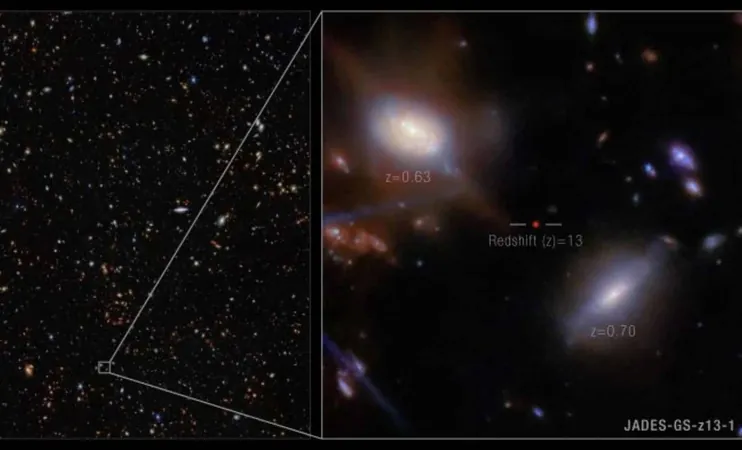
Astronomers Unveil Shocking Discovery: Distant Galaxy’s Light Challenges Early Universe Theories!
2025-04-22
Author: Olivia
In a groundbreaking revelation, astronomers utilizing the James Webb Space Telescope (JWST) have detected an astonishing signal from a remote galaxy, JADES-GS-z13-1, existing merely 330 million years after the Big Bang. This discovery has the potential to flip our understanding of the early universe on its head!
A Light Shining From Within the Cosmic Fog
Traditionally, scientists believed that the universe at this period was enveloped in a thick layer of neutral hydrogen gas that should have obstructed any light emissions. However, the unmistakable Lyman-α signal from JADES-GS-z13-1 has shaken these assumptions, prompting new questions about the epoch of reionization—the era when the first stars and galaxies began to illuminate and ionize the cosmos.
Revealing Secrets From the Depths of Time
The unprecedented capabilities of the JWST, particularly through its Near-Infrared Camera (NIRCam), made it possible to capture deep images of this galaxy. The astounding distance of JADES-GS-z13-1 was later corroborated by the Near-Infrared Spectrograph (NIRSpec), revealing a redshift of z = 13.0, indicating that the light we see has traveled for over 13.4 billion years—an echo from the universe’s infancy!
An Emission That Defies Expectations!
What truly took scientists by surprise was the galaxy's spectral fingerprint. The pronounced Lyman-α emission line—typically suppressed in early epochs—revealed that photons could escape into space without being scattered or absorbed. This suggests that JADES-GS-z13-1 may have created a massive ionized bubble around itself, where hydrogen atoms had already lost their electrons under the influence of intense radiation.
A Game-Changer for Cosmology!
Roberto Maiolino from the University of Cambridge remarked, "The early Universe was bathed in a thick fog of neutral hydrogen, yet here we find a beacon of light. This unexpected result raises fundamental questions about the timing and nature of the reionization process." Kevin Hainline from the University of Arizona echoed this sentiment, emphasizing the difficulty of finding galaxies in such a cloudy early cosmos.
Possible Origins of this Intense Radiation
The powerful radiation emission is still under scrutiny. Scientists speculate it might stem from Population III stars, the hypothetical first generation of massive stars, or an early active galactic nucleus (AGN) powered by a burgeoning black hole.
A New Chapter in Understanding Cosmic History
The implications of this discovery are monumental. If galaxies like JADES-GS-z13-1 could ionize their environments so quickly, it might indicate that the reionization era began much sooner than we currently believe. Furthermore, it suggests that this process was not uniform but occurred in localized bubbles across the primordial universe, each potentially sparked by brilliant luminous sources scattered throughout the cosmos.









 Brasil (PT)
Brasil (PT)
 Canada (EN)
Canada (EN)
 Chile (ES)
Chile (ES)
 Česko (CS)
Česko (CS)
 대한민국 (KO)
대한민국 (KO)
 España (ES)
España (ES)
 France (FR)
France (FR)
 Hong Kong (EN)
Hong Kong (EN)
 Italia (IT)
Italia (IT)
 日本 (JA)
日本 (JA)
 Magyarország (HU)
Magyarország (HU)
 Norge (NO)
Norge (NO)
 Polska (PL)
Polska (PL)
 Schweiz (DE)
Schweiz (DE)
 Singapore (EN)
Singapore (EN)
 Sverige (SV)
Sverige (SV)
 Suomi (FI)
Suomi (FI)
 Türkiye (TR)
Türkiye (TR)
 الإمارات العربية المتحدة (AR)
الإمارات العربية المتحدة (AR)